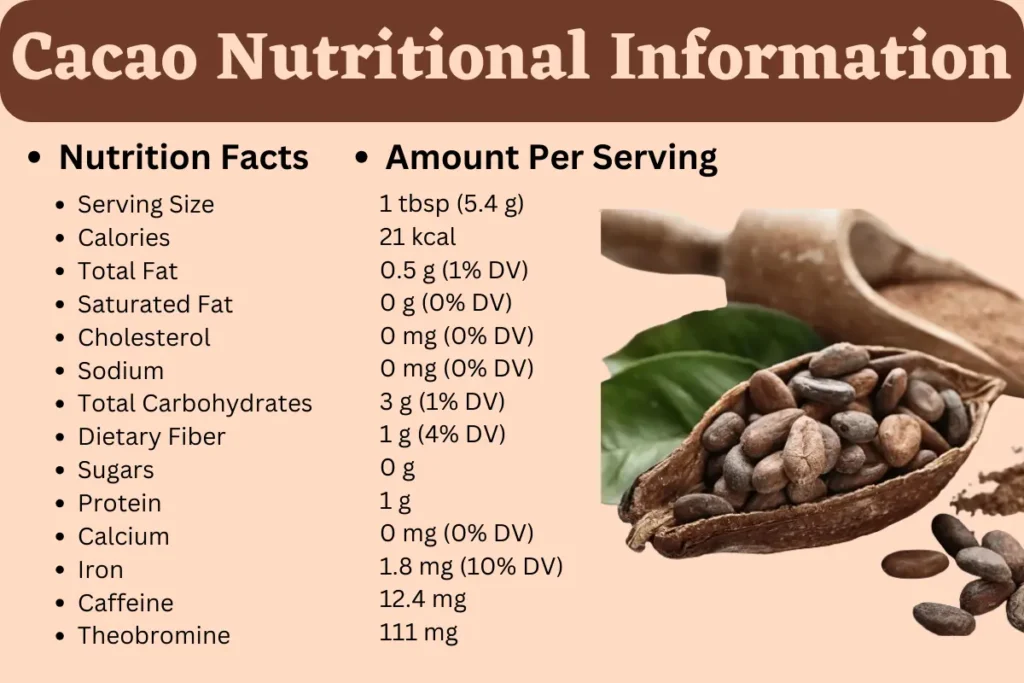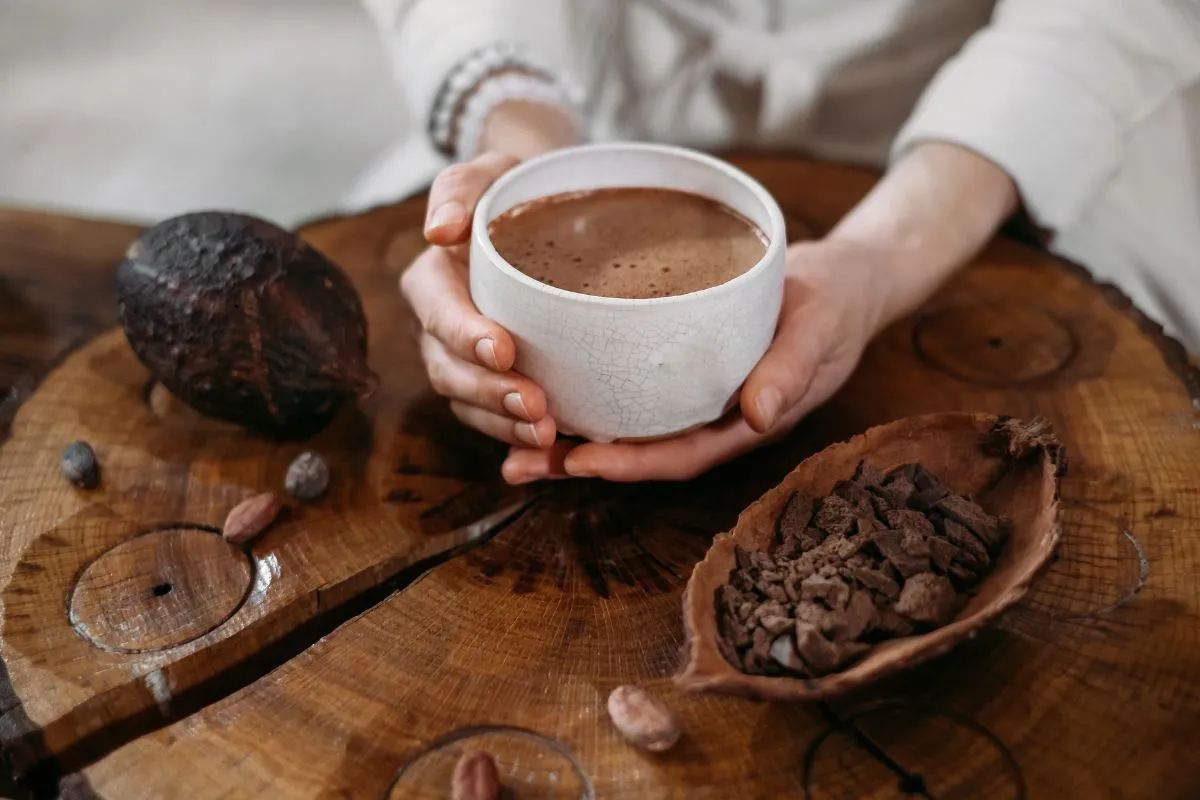The nuanced flavors of cacao are cherished by chocolate enthusiasts worldwide. However, a question often asked is: Does Cacao Have Caffeine? Cacao, the foundation of all chocolate, has a rich history and potential health associations.
Understanding the presence of caffeine in cacao allows consumers to make informed decisions about their chocolate consumption habits.
Importance of Knowing About Cacao
Cacao, the primary ingredient in chocolate, is enjoyed by millions of people worldwide. The United States, Germany, Switzerland, and the United Kingdom are among the top consumers of chocolate per capita, with the global chocolate market expected to reach $205.55 billion by 2030, driven by the increasing demand for premium and healthy chocolate options.
While cacao products are enjoyed by people of all ages, the target audience for specific products may vary based on their caffeine content and nutritional profile. Dark chocolate with high cacao content is often marketed towards health-conscious adults, while milk chocolate is more popular among children and those with a sweeter palate.
However, individuals sensitive to caffeine, such as pregnant women, children, and people with anxiety disorders or sleep issues, may need to limit or avoid cacao products with high caffeine content. Those with allergies to cacao or its components should also refrain from consuming cacao products.
One important point to note here is that not all chocolate contains high levels of caffeine. The caffeine content varies greatly depending on the type of chocolate and the percentage of cacao used. Dark chocolate typically contains more caffeine than milk chocolate, while white chocolate has little to no caffeine. It is essential to read labels and understand the caffeine content of specific products.
Several other factors influence the caffeine content in cacao products, including the cacao percentage, processing methods, origin of cacao beans, and additional ingredients. Higher cacao percentages generally indicate higher caffeine content and the way cacao beans are processed and roasted can impact caffeine levels.
Cacao beans from different regions may have varying caffeine content due to factors such as soil composition and climate, and the addition of other ingredients, such as coffee or tea extracts, can increase the caffeine content of cacao products.
Does Cacao Have Caffeine?
Yes, cacao is not entirely caffeine-free. While it’s true that it contains a smaller amount of caffeine compared to traditional caffeinated beverages like coffee or tea, there is still a trace amount present. For example, cacao powder has about 6.6mg of caffeine per teaspoon, and cacao nibs contain about 4.6mg of caffeine per teaspoon. On the other hand, a typical 8-ounce (240-milliliter) cup of coffee contains about 95 milligrams of caffeine.
What makes cacao unique is the presence of another stimulant called theobromine. This compound belongs to the same family as caffeine but offers a different type of stimulation.
Theobromine provides a gentler, more sustained energy lift, promoting focus and alertness without the potential jittery side effects or sharp energy crash often associated with high caffeine intake.
For individuals who are sensitive to caffeine or looking to avoid it entirely, it is essential to read labels carefully and choose cacao products with lower percentages of cacao solids or opt for caffeine-free alternatives. Some manufacturers also offer decaffeinated chocolate options, which have undergone a process to remove most of the caffeine content.
Cacao Variants and their Caffeine Content
Cacao, the primary ingredient in chocolate, comes in several forms and variants. Each type has its unique characteristics, flavors, and uses in the production of chocolate and other cacao-based products. Here are some of the main cacao variants:
Cacao Beans
These are the seeds of the cacao fruit and the primary source of all cacao products. Cacao beans are typically fermented, dried, and roasted before being processed into various forms.
Cacao Nibs
These are broken pieces of roasted cacao beans that have had their outer shell removed. Nibs have a crunchy texture and intense chocolate flavor, making them a popular addition to baked goods, trail mixes, and other snacks.
Cacao Powder
This is made by grinding roasted cacao beans and removing most of the cocoa butter. The resulting powder is used in baking, as a flavoring in beverages, and as a key ingredient in many chocolate products.
Dutched Cocoa Powder
Also known as alkalized cocoa powder, this variant is treated with an alkalizing agent to reduce acidity, resulting in a milder flavor and darker color compared to natural cacao powder.
Cocoa Butter
The natural fat extracted from cacao beans, cocoa butter is a key ingredient in chocolate production, giving it a smooth texture and melt-in-your-mouth quality.
Raw Cacao
This refers to cacao beans that have not been roasted. Raw cacao is often used in health food products and is believed to retain more of the bean’s original nutritional content.
Single-Origin Cacao
This term refers to cacao sourced from a specific geographical region, such as Venezuela, Ecuador, or Ghana. Single-origin cacao is prized for its unique flavor profile, which is influenced by factors such as soil composition, climate, and processing methods.
Criollo, Forastero, and Trinitario
These are the three main genetic varieties of cacao. Criollo is considered the rarest and most prized for its delicate flavor, while Forastero is the most common and has a stronger, more robust taste. Trinitario is a hybrid of Criollo and Forastero, combining characteristics of both varieties.
List of Ingredients in Cacao
Here is a list of the main ingredients found in cacao:
- Cacao beans: The primary ingredient in cacao products, which are fermented, dried, and roasted to develop their flavor.
- Cocoa butter: The natural fat extracted from cacao beans, which gives chocolate its smooth texture and melt-in-your-mouth quality.
- Theobromine: A bitter alkaloid compound found in cacao that has effects similar to caffeine, although milder.
- Caffeine: A stimulant naturally present in cacao beans, although in lower quantities compared to coffee.
- Flavonoids: Antioxidants found in cacao that may offer potential health benefits, such as improved heart health and reduced inflammation.
- Minerals: Cacao contains essential minerals such as magnesium, iron, zinc, and potassium.
- Phenylethylamine: A compound found in cacao that may have mood-enhancing effects and contribute to the feeling of pleasure associated with consuming chocolate.
- Tryptophan: An amino acid found in cacao that is a precursor to serotonin, a neurotransmitter that helps regulate mood, sleep, and appetite.
- Anandamide: A fatty acid neurotransmitter found in cacao that may have mood-enhancing effects and contribute to the feeling of well-being.
- Sugar: Often added to cacao products to balance the bitterness and create a more palatable flavor profile.
- Lecithin: An emulsifier that helps improve the texture and stability of chocolate products, often derived from soy or sunflower.
- Vanilla: A common flavoring added to enhance the taste of cacao products.
- Additional Ingredients: Some products may also contain additional ingredients, such as milk, nuts, or other flavorings.
Cacao Nutritional Information

A tablespoon of cacao powder (5.4 g) delivers approximately 21 calories. It’s very low in fat, with only 0.5 grams per serving and no saturated fat or cholesterol. Cacao powder contains 3 grams of total carbohydrates, including 1 gram of dietary fiber, but no added sugar.
It offers 1 gram of protein and provides a meaningful source of iron (1.8 mg, or 10% of your daily value). Importantly, cacao powder contains caffeine (around 12.4 mg per tablespoon) as well as a larger serving of theobromine (approximately 111 mg per tablespoon).
| Nutrition Facts | Amount Per Serving |
| Serving Size | 1 tbsp (5.4 g) |
| Calories | 21 kcal |
| Total Fat | 0.5 g (1% DV) |
| Saturated Fat | 0 g (0% DV) |
| Cholesterol | 0 mg (0% DV) |
| Sodium | 0 mg (0% DV) |
| Total Carbohydrates | 3 g (1% DV) |
| Dietary Fiber | 1 g (4% DV) |
| Sugars | 0 g |
| Protein | 1 g |
| Calcium | 0 mg (0% DV) |
| Iron | 1.8 mg (10% DV) |
| Caffeine | 12.4 mg |
| Theobromine | 111 mg |
Alternatives to Cacao and their Caffeine Content
Here are some popular alternatives to cacao, along with a breakdown of their caffeine content to help you make informed choices:
Carob
A popular and truly caffeine-free substitute for cacao, carob is derived from the pods of the carob tree. It offers a naturally sweet and slightly roasted flavor, making it a great option for those avoiding caffeine or seeking a milder taste profile.
Chicory Root
Often used as a coffee alternative, chicory root can also work as a substitute for cacao, although its flavor is quite different. Chicory has a slightly bitter, roasted flavor with nutty notes, contributing complexity and depth to beverages and baking. It’s naturally caffeine-free.
Mesquite
Made from the pods of the mesquite tree, mesquite powder boasts a unique flavor profile with hints of caramel, smoke, and molasses. It’s naturally caffeine-free and provides some added sweetness.
Maca
Not strictly a cacao replacement, maca root powder is a popular superfood. With a slightly nutty and earthy flavor, it can be incorporated into smoothies or baked goods. Maca is caffeine-free but is known for its energizing properties, offering an alternative boost.
Caffeine-Reduced Cocoa Products
Some brands produce specialty cocoa powders with reduced caffeine levels. While not entirely caffeine-free, these allow for a lower caffeine intake while retaining the classic chocolatey flavor.
| Product | Caffeine Content |
| Carob | Caffeine-free |
| Chicory Root | Caffeine-free |
| Mesquite | Caffeine-free |
| Maca | Caffeine-free |
Recommended Daily Intake of Cacao
The recommended daily caffeine intake for most healthy adults is approximately 400 mg. In comparison, a single tablespoon (5.4g) of cacao powder contains about 12.4mg of caffeine, which is roughly 3.1% of the recommended daily intake. This means cacao has a relatively low caffeine content compared to beverages like coffee or tea.
While a smaller amount of caffeine is present, cacao also contains theobromine, a similar stimulant that provides a gentle and sustained energy boost. The combination of these compounds contributes to the unique effects you might experience when consuming cacao products.
It’s important to note that the exact caffeine and theobromine levels can vary slightly depending on the specific type of cacao and its processing.
Conclusion
Whether you enjoy the effects of cacao’s caffeine content is a matter of personal preference. For those seeking a stimulating beverage with less intensity than coffee, cacao could be a delightful and flavorful alternative. Furthermore, cacao’s abundance of antioxidants and mood-boosting compounds offer a potential way to indulge while supporting your well-being.
If you’re highly sensitive to caffeine, start with small amounts and monitor your body’s response; you might be pleasantly surprised at how cacao differs from your usual caffeinated beverages.
FAQs
What is the primary source of caffeine in cacao?
Cacao contains a small amount of caffeine, naturally present within the plant. However, the primary stimulant found in cacao is theobromine, a compound similar to caffeine but with milder, longer-lasting effects.
Does cacao provide a significant energy boost?
Cacao can offer a gentle energy boost due to the presence of both caffeine and theobromine. This boost is typically less intense and more sustained than the jolt you might get from coffee. Additionally, the high levels of antioxidants and nutrients in cacao can contribute to feelings of alertness and focus.
Can excessive consumption of cacao lead to caffeine-related side effects?
While cacao contains less caffeine than coffee, consuming an excessive amount can still lead to some caffeine-related side effects in sensitive individuals. These might include jitters, anxiety, or difficulty sleeping.
Is there caffeine in raw cacao?
Yes, raw cacao contains caffeine and theobromine. The processing of cacao into chocolate products can slightly alter the levels of these compounds, but they are naturally present in the raw bean.
Is there more caffeine in cacao than coffee?
No, a typical cup of coffee has significantly more caffeine than cacao. Cacao offers a gentler boost with its combination of theobromine and a smaller dose of caffeine.
Does cacao keep you awake?
Cacao is less likely to disrupt your sleep compared to coffee, especially if consumed earlier in the day. However, if you’re sensitive to caffeine, consuming cacao too close to bedtime might make it a little harder to fall asleep.

Rossi Glover, the passionate Owner of Grand Lake Coffee, infuses every cup with her love for coffee and dedication to quality. With an extensive background in the art and science of coffee, Rossi is not just a connoisseur but a storyteller, sharing the intricate tales behind each brew.

